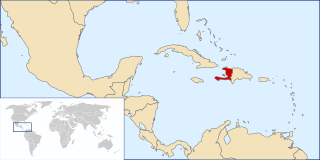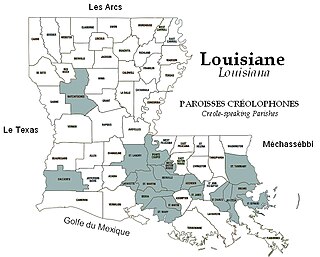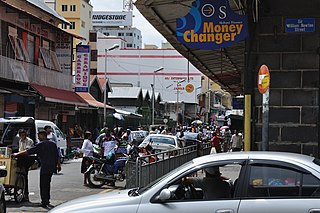A pidgin, or pidgin language, is a grammatically simplified means of communication that develops between two or more groups that do not have a language in common: typically, its vocabulary and grammar are limited and often drawn from several languages. It is most commonly employed in situations such as trade, or where both groups speak languages different from the language of the country in which they reside. Linguists do not typically consider pidgins as full or complete languages.

A creole language, or simply creole, is a stable natural language that develops from the simplifying and mixing of different languages into a new one within a fairly brief period of time: often, a pidgin evolved into a full-fledged language. While the concept is similar to that of a mixed or hybrid language, creoles are often characterized by a tendency to systematize their inherited grammar. Like any language, creoles are characterized by a consistent system of grammar, possess large stable vocabularies, and are acquired by children as their native language. These three features distinguish a creole language from a pidgin. Creolistics, or creology, is the study of creole languages and, as such, is a subfield of linguistics. Someone who engages in this study is called a creolist.

Haitian Creole (; Haitian Creole: kreyòl ayisyen, [kɣejɔl ajisjɛ̃]; French: créole haïtien, [kʁe.ɔl ai.sjɛ̃]; commonly referred to as simply Creole, or Kreyòl in the Creole language, is a French-based creole language spoken by 10–12 million people worldwide, and is one of the two official languages of Haiti, where it is the native language of a majority of the population.
Hawaiian Pidgin is an English-based creole language spoken in Hawaiʻi. An estimated 600,000 residents of Hawaiʻi speak Hawaiian Pidgin natively and 400,000 speak it as a second language. Although English and Hawaiian are the two official languages of the state of Hawaiʻi, Hawaiian Pidgin is spoken by many Hawaiʻian residents in everyday conversation and is often used in advertising targeted toward locals in Hawaiʻi. In the Hawaiian language, it is called ʻōlelo paʻi ʻai – "pounding-taro language". Hawaiian Pidgin was first recognized as a language by the U.S. Census Bureau in 2015. However, Hawaiian Pidgin is still thought of as lower status than the Hawaiian and English languages.

Portuguese creoles are creole languages which have Portuguese as their substantial lexifier. The most widely-spoken creoles influenced by Portuguese are Cape Verdean Creole, Guinea-Bissau Creole and Papiamento.
In addition to its classical and literary form, Malay had various regional dialects established after the rise of the Srivijaya empire in Sumatra, Indonesia. Also, Malay spread through interethnic contact and trade across the Malay Archipelago as far as the Philippines. That contact resulted in a lingua franca that was called Bazaar Malay or low Malay and in Malay Melayu Pasar. It is generally believed that Bazaar Malay was a pidgin, influenced by contact among Malay, Hokkien, Portuguese, and Dutch traders.

Louisiana Creole is a French-based creole language spoken by fewer than 10,000 people, mostly in the state of Louisiana. It is spoken today by people who racially identify as White, Black, mixed, and Native American, as well as Cajun and Louisiana Creole. It should not be confused with its sister language, Louisiana French, a dialect of the French language.

Antillean Creole is a French-based creole that is primarily spoken in the Lesser Antilles. Its grammar and vocabulary include elements of Carib, English, and African languages.
Liberian Kreyol is an Atlantic English-lexicon creole language spoken in Liberia. Also known as Kolokwa, was spoken by 1,500,000 people as a second language which is about 70% of the population in that time. Today the knowledge of some form of English is even more widespread. It is historically and linguistically related to Merico, a creole spoken in Liberia, but is grammatically distinct from it. There are regional dialects such as the Kru kolokwa English used by the Kru fishermen.
Language contact occurs when speakers of two or more languages or varieties interact and influence each other. The study of language contact is called contact linguistics. When speakers of different languages interact closely, it is typical for their languages to influence each other. Language contact can occur at language borders, between adstratum languages, or as the result of migration, with an intrusive language acting as either a superstratum or a substratum.
A mixed language is a language that arises among a bilingual group combining aspects of two or more languages but not clearly deriving primarily from any single language. It differs from a creole or pidgin language in that, whereas creoles/pidgins arise where speakers of many languages acquire a common language, a mixed language typically arises in a population that is fluent in both of the source languages.
Nigerian Pidgin, also called Naijá or Naija in scholarship, is an English-based creole language spoken as a lingua franca across Nigeria. The language is sometimes referred to as "Pijin" or Broken. It can be spoken as a pidgin, a creole, slang or a decreolised acrolect by different speakers, who may switch between these forms depending on the social setting. A common orthography has been developed for Pidgin which has been gaining significant popularity in giving the language a harmonized writing system.

Sierra Leonean Creole or Krio is an English-based creole language that is lingua franca and de facto national language spoken throughout the West African nation of Sierra Leone. Krio is spoken by 87% of Sierra Leone's population and unites the different ethnic groups in the country, especially in their trade and social interaction with each other. Krio is the primary language of communication among Sierra Leoneans at home and abroad. The language is native to the Sierra Leone Creole people, or Krios, a community of about 95,000 descendants of freed slaves from the West Indies, Canada, United States and the British Empire, and is spoken as a second language by millions of other Sierra Leoneans belonging to the country's indigenous tribes. English is Sierra Leone's official language, and Krio, despite its common use throughout the country, has no official status.

Cameroonian Pidgin English, or Cameroonian Creole, is a language variety of Cameroon. It is also known as Kamtok. It is primarily spoken in the North West and South West English speaking regions. Five varieties are currently recognised:

Réunion Creole, or Reunionese Creole, is a French-based creole language spoken on Réunion. It is derived mainly from French and includes terms from Malagasy, Hindi, Portuguese, Gujarati and Tamil. In recent years, there has been an effort to develop a spelling dictionary and grammar rules. Partly because of the lack of an official orthography but also because schools are taught in French, Réunion Creole is rarely written. Notably, two translations of the French comic Asterix have been published.
An Arabic-based creole language, or simply Arabic creole is a creole language which was significantly influenced by the Arabic language.

A French creole, or French-based creole language, is a creole language for which French is the lexifier. Most often this lexifier is not modern French but rather a 17th-century koiné of French from Paris, the French Atlantic harbors, and the nascent French colonies. By the eighteenth century, Creole French was the first language of many people including those of European origin in the Caribbean. French-based creole languages today are spoken natively by millions of people worldwide, primarily in the Americas and on archipelagos throughout the Indian Ocean. This article also contains information on French pidgin languages, contact languages that lack native speakers.
A post-creole continuum is a dialect continuum of varieties of a creole language between those most and least similar to the superstrate language. Due to social, political, and economic factors, a creole language can decreolize towards one of the languages from which it is descended, aligning its morphology, phonology, and syntax to the local standard of the dominant language but to different degrees depending on a speaker's status.

The Constitution of Mauritius mentions no official language. It only contains a statement in Article 49 that "The official language of the Assembly shall be English but any member may address the chair in French," implying that English and French are official languages of the National Assembly (parliament). However, the majority language and lingua franca of the country is the French-based Mauritian Creole, spoken at home by 86.5% of the population. Bhojpuri is the second most spoken language in Mauritius, used by 5.3%. The usage of this language is decreasing day by day. English is used as the prime medium of instruction in public schools while French is also a common language in education and the dominant language of media. According to the Organisation internationale de la Francophonie, 72.7% of the Mauritians were French speakers in 2005. Mauritius shares this distinction of being both English- and French-speaking with Burundi, Canada, Cameroon, Dominica, Rwanda, Seychelles and Vanuatu.
Ngatikese Creole, also called Ngatik Men's Creole, is a creole language spoken mostly on the atoll of Sapwuahfik in the Caroline Islands. It is spoken by about 500 on the atoll, and by another 200 on the nearby major island of Pohnpei. It is a creole consisting of English and Sapwuahfik Pohnpeian spoken primarily by men, especially when engaged in communal activities such as fishing or boat-building, but is readily understood by women and children. It is used as a secret language by Ngatikese people when they are in the presence of Pohnpeian speakers.









